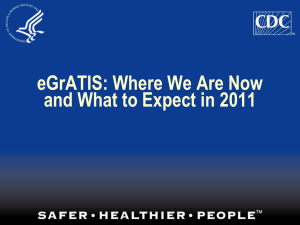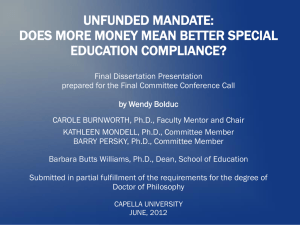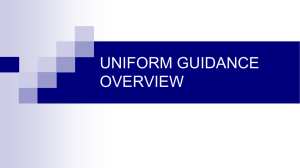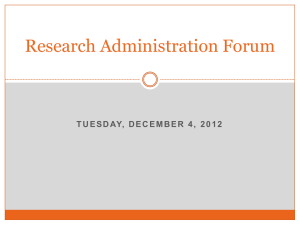Compliance Requirement - North Carolina State Treasurer
advertisement
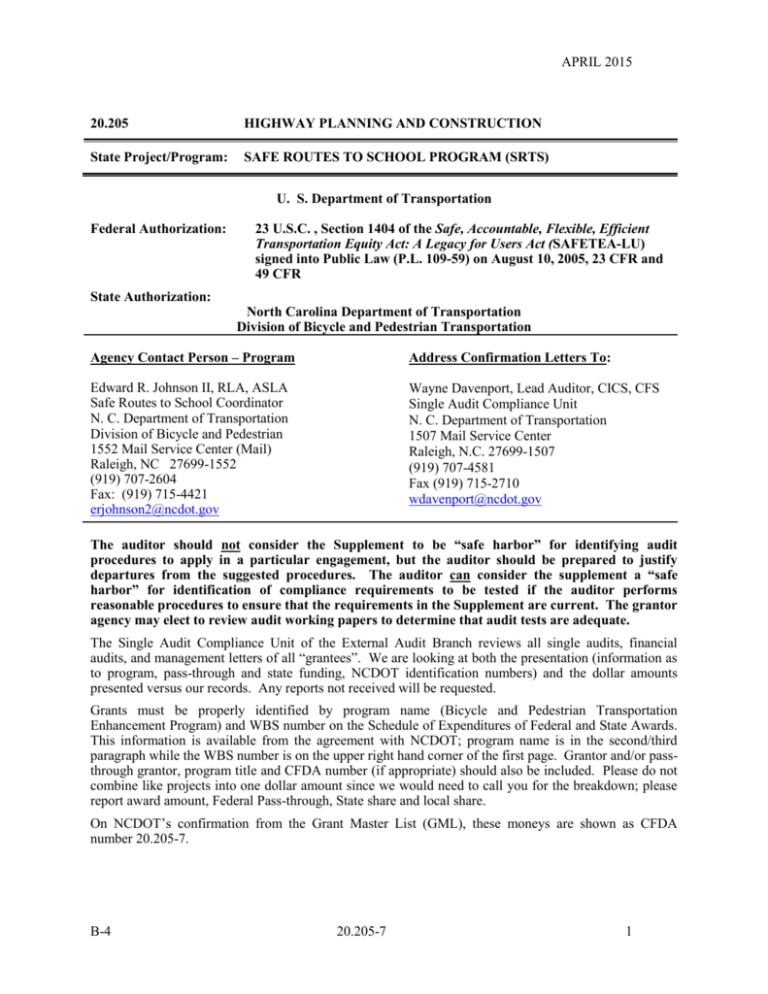
APRIL 2015 20.205 HIGHWAY PLANNING AND CONSTRUCTION State Project/Program: SAFE ROUTES TO SCHOOL PROGRAM (SRTS) U. S. Department of Transportation Federal Authorization: 23 U.S.C. , Section 1404 of the Safe, Accountable, Flexible, Efficient Transportation Equity Act: A Legacy for Users Act (SAFETEA-LU) signed into Public Law (P.L. 109-59) on August 10, 2005, 23 CFR and 49 CFR State Authorization: North Carolina Department of Transportation Division of Bicycle and Pedestrian Transportation Agency Contact Person – Program Address Confirmation Letters To: Edward R. Johnson II, RLA, ASLA Safe Routes to School Coordinator N. C. Department of Transportation Division of Bicycle and Pedestrian 1552 Mail Service Center (Mail) Raleigh, NC 27699-1552 (919) 707-2604 Fax: (919) 715-4421 erjohnson2@ncdot.gov Wayne Davenport, Lead Auditor, CICS, CFS Single Audit Compliance Unit N. C. Department of Transportation 1507 Mail Service Center Raleigh, N.C. 27699-1507 (919) 707-4581 Fax (919) 715-2710 wdavenport@ncdot.gov The auditor should not consider the Supplement to be “safe harbor” for identifying audit procedures to apply in a particular engagement, but the auditor should be prepared to justify departures from the suggested procedures. The auditor can consider the supplement a “safe harbor” for identification of compliance requirements to be tested if the auditor performs reasonable procedures to ensure that the requirements in the Supplement are current. The grantor agency may elect to review audit working papers to determine that audit tests are adequate. The Single Audit Compliance Unit of the External Audit Branch reviews all single audits, financial audits, and management letters of all “grantees”. We are looking at both the presentation (information as to program, pass-through and state funding, NCDOT identification numbers) and the dollar amounts presented versus our records. Any reports not received will be requested. Grants must be properly identified by program name (Bicycle and Pedestrian Transportation Enhancement Program) and WBS number on the Schedule of Expenditures of Federal and State Awards. This information is available from the agreement with NCDOT; program name is in the second/third paragraph while the WBS number is on the upper right hand corner of the first page. Grantor and/or passthrough grantor, program title and CFDA number (if appropriate) should also be included. Please do not combine like projects into one dollar amount since we would need to call you for the breakdown; please report award amount, Federal Pass-through, State share and local share. On NCDOT’s confirmation from the Grant Master List (GML), these moneys are shown as CFDA number 20.205-7. B-4 20.205-7 1 SAFE ROUTES TO SCHOOL PROGRAM I. PROGRAM OBJECTIVES Safe Routes to School (SRTS) is a federally mandated program with many benefits to the communities and people who participate in its program. The purposes of the program are to: (1) enable and encourage children, including those with disabilities, to walk and bicycle to school, (2) make bicycling and walking to school a safer and more appealing transportation alternative, thereby encouraging a healthy and active lifestyle from an early age, and (3) facilitate the planning, development, and implementation of projects and activities that will improve and reduce traffic, fuel consumption, and air pollution in the vicinity of schools. II. PROGRAM PROCEDURES Through a competitive process, communities may use this program funding to construct new bike lanes, pathways, and sidewalks, as well as to launch Safe Routes education and promotion campaigns in elementary and middle schools. There is no local funding match required since this program is 100% federally funded. Grant applications are comprehensive in nature and address infrastructure (engineering) and non-infrastructure (education, enforcement and encouragement) aspects. Eligible recipients include state, local and regional agencies, and non-profit organizations. Jurisdictional levels for the grant are school level, school system or region-wide, and state-wide. Primary beneficiaries must be K-8th grade students. Infrastructure projects must be within two miles of a school and on public property or private land with legal public-access easements. A funded entity must be willing to execute a legal agreement with the NCDOT prior to receiving funding. This agreement will outline the responsibilities of each party, the terms of reimbursement and the deliverables. Selected entities will receive a formal Notice to Proceed from NCDOT. Costs incurred before this time are not a reimbursable expense. Funding is provided on a reimbursement basis. III. COMPLIANCE REQUIREMENTS The federal granting agency has issued a compliance supplement that should be used in conjunction to this compliance supplement issued by the State Agency. Please refer to OMB Circular A-133 Compliance Supplement (Sect. A of the State Compliance supplement) as well as 2 CFR 200 (referred to as the “Supercircular”). In developing the audit procedures to test compliance with the requirements for a Federal program, the auditor should first look to OMB A-133 Compliance Supplement, Part 2, Matrix of Compliance Requirements, to identify which of the 14 types of compliance requirements described in Part 3 are applicable and then look to Parts 3 and 4 for the details of the requirements. The OMB A-133 Compliance Supplement may be found at www.whitehouse.gov/omb/circulars/index.html. OMB has issued an addendum to Circular A-133 on June 30, 2009. This addendum supplements the 2010 OMB Circular A-133 Compliance Supplement (Supplement) to provide additional guidance for programs (including clusters of programs) with expenditures of American Recovery and Reinvestment Act of 2009 (Pub. L. No. 111-5) (ARRA) awards that the auditor determines are major programs in audits performed under OMB Circular A-133. This addendum is effective for audits of fiscal years beginning after June 30, 2008. It should be used in conjunction with other Parts and Appendices of the Compliance Supplement in determining the appropriate audit procedures to support the auditor’s opinion on compliance for each major program with expenditures of ARRA awards. This addendum may be found at B-4 20.205-7 2 SAFE ROUTES TO SCHOOL PROGRAM http://www.whitehouse.gov/omb/assets/a133_compliance/arra_addendum_1.pdf. Please also refer to 2 CFR 200 Implementation Guidance at http://www.fhwa.dot.gov/cfo/2cfr200guidance.cfm , issued December 4, 2014 for further understanding and guidance. A. ACTIVITIES ALLOWED OR UNALLOWED 1. Compliance Requirements - Funds must be expended as specified in the reimbursement agreement and specifications which incorporate the grantee’s application (scope of services) by reference. Audit Objective – Determine that expenditures were made as specified in the reimbursement agreement and scope of project. Suggested Audit Procedure - Ascertain whether or not expenditures were for items specified in the reimbursement agreement and letter giving notice to proceed with project. B. ALLOWABLE COSTS / COST PRINCIPLES 1. Compliance Requirement - Local units of government including cities, counties, and airport authorities chartered by the General Assembly are eligible for grants. These local units of government should be eligible for sales tax refunds under G.S. 105-164.14 (b) or (c); if they cannot qualify, then these local units of government should take the steps necessary to become eligible. Sales tax paid which may be requested from the N. C. Department of Revenue as a refund is an ineligible charge. Audit Objective - Determine that the authority is eligible for the refund and that NCDOT did not reimburse any sales taxes eligible for refund. Suggested Audit Procedure - Review financial records and ascertain that no sales taxes were billed to the project. C. CASH MANAGEMENT The grant is funded on a reimbursement basis; therefore, no testing is required at the local level. D. DAVIS-BACON ACT Compliance Requirement - Infrastructure projects under the Safe Routes to School program must comply with Davis-Bacon prevailing wage rates, competitive bidding, and other contracting requirements, etc, even for projects not located within the right-of-way of a federal-aid highway. F. EQUIPMENT AND REAL PROPERTY MANAGEMENT Compliance Requirement – NCDOT has adopted the policies and procedures for equipment and real property contained in OMB Circular A-110 or 49 CFR Part 18.32. This information can be found at http://www.whitehouse.gov/omb/circulars/a110/a110.html and http://www.gpoaccess.gov/cfr/index.html respectively. B-4 20.205-7 3 SAFE ROUTES TO SCHOOL PROGRAM G. MATCHING, LEVEL OF EFFORT, EARMARKING 1. Matching No local match is permitted with the SRTS program. The Federal share of the cost of the project or activity is 100 percent. 2. Level of Effort - No testing required at the local level. 3. Earmarking - No testing required at the local level. I. PROCUREMENT, SUSPENSION & DEBARMENT Procurement Compliance Requirement - American Recovery and Reinvestment Act Reporting (ARRA). In addition to those statutes listed in the A-102 Common Rule and OMB Circular A-110, Section 1605 of ARRA prohibits the use of ARRA funds for a project for the construction, alteration, maintenance, or repair of a public building or work unless all of the iron, steel, and manufactured goods used in the project are produced in the United States. ARRA provides for waiver of these requirements under specified circumstances. An award term is required in all awards for construction, alteration, maintenance, or repair of a public building or public work (2 CFR section 176.140). Further information about this requirement, including applicable definitions, is found in 2 CFR part 176, Subpart B located at http://edocket.access.gpo.gov/2009/pdf/E9-9073.pdf. Audit Objective – Determine whether an award using ARRA funding includes a BuyAmerican award term and, if so, whether the recipient is complying with the Buy-American provisions of ARRA or if any waivers have been granted. Suggested Audit Procedure – Select a sample of ARRA-funded procurements, if any, for activities subject to Section 1605 of ARRA and test whether the non-Federal entities requested and received any exceptions to Buy-American requirements; and test the sample of procurements to ascertain if entities are otherwise in compliance with the ARRA requirements. Solicitation of Bids Compliance Requirement - N.C. General Statute 143-129 requires the solicitation of bids on construction or repair work requiring expenditure of public money in an amount equal to or more than five hundred thousand dollars ($500,000) or purchases in an amount equal to or more than ninety thousand dollars ($90,000). N.C. General Statute 143-131 states that all contracts for construction or repair work or for the purchase of apparatus, supplies, materials, or equipment, involving the expenditure of public money in the amount of thirty thousand dollars ($30,000) or more, but less than the limits prescribed in N.C. General Statute 143-129, shall be made after informal bids have been secured. Bid tabulation and governing agency resolution recommending award is required for contract award to the lowest responsible bidder. B-4 20.205-7 4 SAFE ROUTES TO SCHOOL PROGRAM Audit Objective – Determine if bids, formal or informal, were required and if required were received. Suggested Audit Procedure - Verify that municipality has properly solicited bids and that the contract was awarded to the lowest qualified. J. PROGRAM INCOME NCDOT does not pass this requirement down to the local level. No testing is required. L. REPORTING The auditor should look to OMB A-133 Compliance Supplement, Part 3-L for local government reporting. Non-governmentals – Reports made by non-State entities Compliance Requirement – North Carolina General Statute 143C-6-23 “Use of State Funds by Non-State Entities,” and North Carolina Administrative Code Chapter 9, Subchapter 03M “Uniform Administration of State Grants” addresses reporting requirements for nongovernmental entities. These regulations along with reporting forms may be accessed at: https://www.ncgrants.gov/NCGrants/Regulations.jsp https://www.ncgrants.gov/NCGrants/PublicReportsRegulations.jsp Audit Objective – Determine applicable reporting requirements. Suggested Audit Procedure 1. Determine if the organization is subject to North Carolina General Statute 143C-6-23. 2. Determine what type of filing/report should be made with the NCDOT. Compliance Requirement - American Recovery and Reinvestment Act Reporting (ARRA). The NC Department of Transportation (NCDOT) is responsible for reporting project ARRA data to the Federal awarding agency. The subrecipient is responsible for reporting project ARRA data to NCDOT. Appropriate documents to meet the reporting requirements are provided to the subrecipient independent of the contract. In all cases (including months where no project work was performed), Project Status Reports are due to NCDOT by the 5th of each month and Employment Data Reports are due to NCDOT by the 7th of each month until the completion of the project. Audit Objective – Determine that monthly Project Status Reports and Employment Data Reports were submitted timely and are accurately prepared. Suggested Audit Procedure - Ascertain that the grantee has accurately prepared the two ARRA data reports and documentation supports the reports. B-4 20.205-7 5 SAFE ROUTES TO SCHOOL PROGRAM M. SUBRECIPIENT MONITORING Compliance Requirement - American Recovery and Reinvestment Act: A pass through entity is responsible for identifying to the first-tier subrecipients the requirement to register in the Central Contractor Registration (CRC), including obtaining a Dun and Bradstreet Data Universal Numbering System (DUNS) number, and maintain the currency of that information (Section 1512(h), ARRA, and 2 CFR 176.50(c)). Audit Objective – Determine whether the pass-through entity determined that subrecipients have current CCR registrations prior to making subawards and performed periodic checks to ensure that subrecipients are updating information as necessary. Suggested Audit Procedure – Test the pass-through entity’s subaward review and approval documents to determine whether, before award, the pass-through entity checked CCR to determine whether subrecipients were registered. N. SPECIAL TESTS AND PROVISIONS Compliance Requirement - For most federally participating highway projects, the SHA or municipality must abide by Equal Employment Opportunity, Prohibited Interests, Title VI Civil Rights Act of 1964, Davis-Bacon Wage Scale, and MBE/DBE Policies and Guidelines. Audit Objective - Obtain an understanding of the recipient’s program and ascertain if the program incorporates the above policies. Suggested Audit Procedure Review contracts for compliance with stated policies. Special Tests and Provisions for Awards with ARRA Funding: 1. Compliance Requirement – As provided in 2 CFR section 176.210, recipients of ARRA funds must maintain records that identify adequately the source and application of ARRA awards. Audit Objective – Determine whether accounting records for ARRA funds provide for the separate identification and accounting required for ARRA awards and activity. Suggested Audit Procedure – Ascertain if expenditures of ARRA awards are accounted for separately from expenditures of non-ARRA awards. 2. Compliance Requirement – Recipients of ARRA funds must identify the ARRA awards in their Schedule of Expenditures of Federal Awards (SEFA). Audit Objective – Determine whether the entity met the requirements for reporting expenditures of ARRA awards on the SEFA and that reported amounts are supported by the accounting records and fairly presented in accordance with ARRA and program requirements. Suggested Audit Procedure – Verify that the SEFA properly identifies and reports expenditures of ARRA awards and that reported expenditures are supported by accounting records. B-4 20.205-7 6 SAFE ROUTES TO SCHOOL PROGRAM 3. Compliance Requirement – If ARRA funds are passed from an entity to a subrecipient, the entity must: (1) separately identify to each subrecipient, and document at the time of the subaward and disbursement of funds, the Federal award number, CFDA number, and the amount of ARRA funds; and (2) require their subrecipients to provide similar identification (as noted in Compliance Requirement number 2 above) in their SEFA and reporting of data. Audit Objective – If subawards of ARRA funds were made, determine whether the entity met the requirements for separately identifying to each subrecipient, and documenting at the time of the subaward and disbursement of funds, the Federal award number, CFDA number, and the amount of ARRA funds; and required their subrecipients to provide appropriate identification in their SEFA and reporting data. Suggested Audit Procedure – Verify that the entity separately identified to each subrecipient, and documented at the time of the subaward and disbursement of funds, the Federal award number, CFDA number, and the amount of ARRA funds; and required their subrecipients to provide appropriate identification in their SEFA and reporting data. B-4 20.205-7 7

